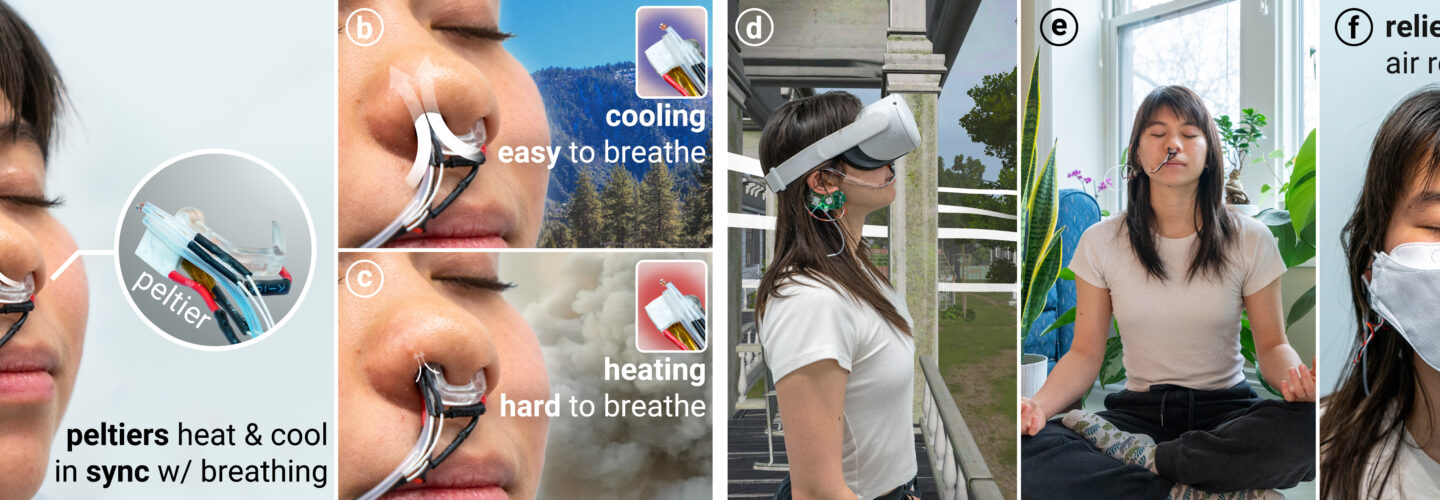New Research Explores Augmented Breathing Through Thermal Feedback
Despite the rapid advancements in AI, humans continue to face everyday challenges that could be alleviated by applying innovative technology. Breathing issues, such as nasal congestion, significantly affect quality of life, yet effective solutions to ease the discomfort remain elusive. Final year Ph.D. candidate Jas Brooks, part of Associate Professor Pedro Lopes’ Human Computer Integration lab at the University of Chicago Department of Computer Science, may have come up with just the solution. Working with UChicago alumnus Alex Mazursky and fourth-year undergraduate Janix Hixon, the team designed a novel nasal interface that utilizes thermal feedback to augment the perception of breathing.

In their first year at UChicago, Brooks took a class with Lopes where there was an assignment to come up with potential user interface ideas. The idea came to them then, and several years later, it was realized in this paper, Augmented Breathing via Thermal Feedback in the Nose.
“In the Fall of 2023, I realized that we could pull this off,” Brooks stated. “There have been previous attempts at technology that’s focused on sensing breathing, such as air pressure sensors or temperature probes, but not much thinking about how we can change how we feel our breath.”
Surprisingly, humans do not have a receptor specifically for detecting the volume of air being inhaled. Instead, previous medical research demonstrates that the nasal vestibule (septum) is a critical area for sensing airflow, with temperature fluctuations, especially the cooling of the nose, triggering the trigeminal nerve and the perception of increased nasal airflow. Building on these physiological findings, Brooks built a device that involves a nose clip and Peltier elements, which are heat pumps that transfer heat from one side to the other, depending on the direction of the electrical current. 
A switch was used to control the Peltier elements that were clipped onto one’s septum, and an air pressure sensor was used to monitor breathing. Starting by experimenting on themselves, Brooks found that the temperature must be applied in sync with the inhalation. Otherwise, if it is out of sync, rather than altering the perceived volume of air, one would experience a hot or cold nose.
To test this device, Brooks recruited ten participants from UChicago. Participants were tasked to identify when they felt a change in their breathing (to determine how much of a change was needed) and also asked to comment on their perceived experience using the device. Of the 389 words used to describe the feeling from transcribed comments, an overwhelming majority (89.2%) pertained to airflow. For example, one participant said their nose felt “much more open,” and another said, “I could just breathe easier because it was fresher air, versus being stuffy”.

Brooks believes this device will have applications in many scenarios, beyond just congestion.
“We were at the Hyde Park Science Festival and a doctor approached,” Brooks recalled. “He thought this would be great for patients wanting to feel like they’re getting fresh air, to improve their quality of life. We also talked about meditation and relaxation. In addition, when it comes to face mask compliance, like during the COVID-19 pandemic, one of the biggest issues was the perceived increased air resistance, so we were interested in using this device to combat that.”
On the flip side, the device could be used to make it harder to breathe. This could be beneficial for athletes training for extreme conditions, such as running in a hot environment, or in the creation of a diving simulator to help people acclimate to the increased air resistance in scuba air tanks.
As for the next steps of this project, Brooks’ main goal is to collaborate with Professor Jayant Pinto, a specialist in sinus and nasal diseases and surgery. Beyond qualitative comments from participants, they are eager to study the quantitative gain that this device may provide when it comes to ease of inhalation, and whether there is variation across people. Brooks is graduating this year and looking forward to continuing this project.
To learn more about their work, please visit the Human Computer Integration lab page and Jas Brooks’ personal website.














